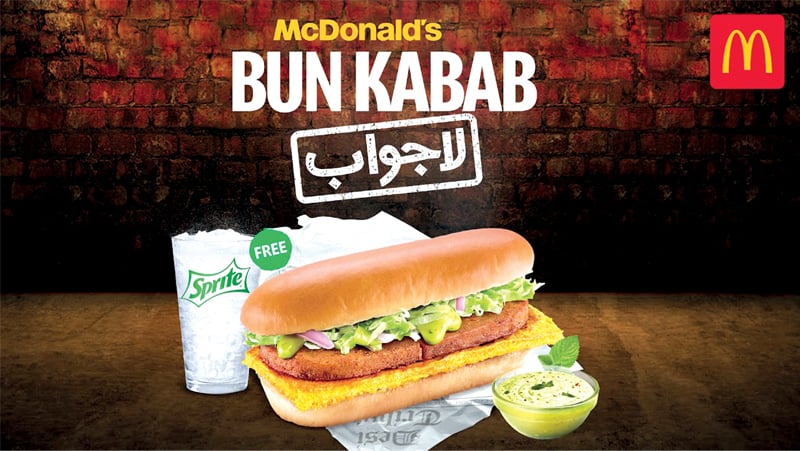McDonald's does another desi
Published in Jul-Aug 2019
On April 1, 2019, McDonald’s Pakistan introduced two products with definitive desi origins: McDonald’s Bun Kabab and McDonald’s Lassi. The bun kabab continues to be available while the lassi was offered for a limited period (it was launched to coincide with Ramzan).
This is not the first time that McDonald’s have experimented with desi offerings. Five years ago, they introduced their Mutton Burger, which like the McDonald's Lassi, was available for a limited amount of time. Two years ago, they added the Chicken Chapli Buger which continues to be available. As the response to both products was encouraging, McDonald’s decided to further expand their desi menu.
"McDonald’s is on the lookout for opportunities to launch products that appeal to the local palette,” says Adeeba Khan, Chief Creative Officer, Strategy, Manhattan Communications (McDonald’s creative agency) and adds that expanding the local menu has became an important area to invest in.
According to Raza Ali, Director Marketing, McDonald’s Pakistan, the fact that bun kababs are extremely popular and available in every nook and corner of Pakistan, introducing them was an astute decision especially because “a significant proportion of our customers refrain from indulging in a bun kabab due the unhygienic conditions they are usually made in. “Hence, we thought, let’s bring it to our restaurant with the promise of hygiene and taste.”
In comparison to McDonald’s more popular offerings, be it McRoyale (Rs 456), the Big Mac (Rs 438) or six chicken nuggets (Rs 341), the Chicken Chapli Buger and Bun Kabab are relatively more affordable as they are priced at Rs 212 and Rs 239 respectively.
Pricing was in fact another reason for introducing these items, especially as Ali points out, given that the informal eating out (IEO) sector in metropolitan cities has remained stagnant in the last three years. He adds that Quick Service Restaurants (QSRs) have a share of 52% within this segment and that McDonald’s is leading the market with a 31% share followed by KFC with 16%. McDonald’s Bun Kabab is consumed primarily by SECs B and C, and is especially popular among young people.
“The recent economic downturn is affecting everyone in Pakistan. With the appreciation of the dollar, disposable incomes have taken a hit and multinational chains like ours are feeling the impact. Our focus in these times is to develop an internationally approved strategy that focuses on value.”
“McDonald’s Bun Kababs are more expensive than the ones available at dhabas [priced anywhere between Rs 50-100], but our customers are willing to pay extra because we provide a hygienic product,” adds Tehmina Siddiqui, Director Operations, Manhattan Communications. To encourage consumption, deals such as offering a free Sprite with McDonald's Bun Kabab have been introduced.
McDonald’s Bun Kabab was promoted via a ‘digitally-led campaign’; print, OOH, activations and radio were used as well, although TV was not, in order to economise.

“As we did not have the budget for TV, we aimed to do something that would attract attention and Ali Gul Pir (singer, comedian and social media celebrity) came to mind,” says Khan who says Pir’s Anday Wala Burger video (the centrepiece of the campaign) went viral very quickly. Furthermore, the fact that the launch date was April 1 added another layer of curiosity as people thought that the campaign was a joke. “With pre-launch teasers, celebrity appeal, and the right message, we were able to intrigue our audience,” she adds.
Developing McDonald's Bun Kabab presented several challenges. Firstly, consumer insights revealed that although bun kababs are extremely popular across Pakistan, they taste slightly different in northern and southern Pakistan, mainly because of the different types of chutneys used; hence, McDonald’s proposition is that theirs is “an amalgamation of two tastes.”
According to Ali, McDonald's Bun Kabab has been in the works for more than a year, but it could only be launched once the company had met international guidelines in terms of the ingredients and equipment used.
“Eggs are essential for bun kababs and because they are allergens, they have to be treated in a certain way; we had to allot a separate set of equipment for our eggs as our buns or patties cannot be grilled on them. Furthermore, we had to have new moulds created for the buns; therefore, our SOPs had to be redefined.”
Packaging too posed its own set of challenges. As bun kababs sold at dhabas come wrapped in newspaper, McDonald’s wanted something similar; however, needless to say, they had different standards to meet.
“The packaging paper had to undergo several changes; edible food-grade ink and appropriate paper material were required and local vendors had to be sourced to produce the wrapping,” says Siddiqui, and adds that the process took several months.
As far as McDonald’s Lassi (developed in collaboration with Nestlé), is concerned, Ali says that it was produced at one of Nestle’s plants in Sheikhupura. “Ensuring its availability in 55 branches across Pakistan required a very reliable distribution network, especially in summer, as milk-based products have a very short shelf-life.”
Despite the challenges, according to Ali, the response to McDonald's Bun Kabab and Lassi has been “phenomenal and the initial targets were superseded.” Given the response, can we assume McDonald’s may introduce more desi offerings? McNihari?
Maybe not.




Comments (8) Closed